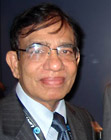
Searching for a Silent Killer, Hypertension – Part II

Measuring your BP
The first step toward the diagnosis of hypertension is an accurate measurement of your BP. Although your BP gets checked in the doctor’s office, for those who want to keep an eye on their numbers or to see if medications are working, get your own kit to measure the BP at home. The most common way is to use a mercury sphygmomanometer with the familiar BP cuff and stethoscope but an automatic digital one, easy to handle and available in all stores, has become the favorite of all patients. In the doctor’s office, some people have high levels of anxiety that result in higher readings, often called ‘white coat hypertension.’ This can be overcome by self- measurements at home with a digital device. Omron (Kyoto, Japan) makes several devices that are not costly.
A few precautions need to be observed before you start the measurement. These are: 1. Don’t drink coffee or smoke cigarettes. 2. Empty your bladder first. 3. Use a cuff appropriate to the size of your arm and apply the cuff properly aligning the recording device of the digital manometer along the pulsation of the radial artery. 4. Sit and relax for 5 minutes and support the arm of a chair or sofa. Get at least two readings, two minutes apart and use the mean of the two.
The Joint National Committee (JNC 7) for Hypertension evaluation and management recommends screening all adult population for hypertension every two years if BP is 120/80 or below and annually if BP is 120/80 to 139/89. Since a person’s BP can vary widely, take several measurements on different days (home monitoring) and use the running average to diagnose hypertension and guide you with proper treatment. Your family doctor can help.
Sometimes, we do ‘Ambulatory blood pressure monitoring’ – a technique that provides 24 or 48 hours worth of readings taken about every 20 minutes, including about every half hour at night. This helps the doctor to determine the average blood pressure and is quite helpful in the choice of therapy. Those who tend to have an early morning rise in BP seem to fare worse long term.
Long-term health risks
The relationship between your BP and cardiovascular disease is linear and continuous, independent of other risk factors you have. And if you do have other problems such as diabetes, kidney disease, obesity etc., then they would be additive. “For persons of age 40-70 years, each increment of 20 mm of Hg in systolic BP or 10 mm in diastolic BP across the range from 115/75 to 185/115 mm Hg doubles the risk,” as per the American College of Medicine. In other words, pre-hypertension is also associated with risks and need proper attention.
The major complications of hypertension include strokes, coronary artery disease and heart attack, kidney disease, heart failure, atrial fibrillation (a cardiac rhythm disorder), retinopathy leading to visual problems and peripheral vascular disease. You already know how devastating and debilitating strokes and heart attacks can be. A majority of patients with strokes we see in hospitals have a history of hypertension, often inadequately controlled. A new research also shows that three major risk factors – hypertension, extreme obesity and black race – can predict how serious or even fatal the first heart attack of a patient can be, so beware!
Management of hypertension
Your doctor will do a thorough physical examination first to determine the status of your heart, eyes, arteries, etc., and look for signs of atherosclerosis. A few simple laboratory tests such as EKG, blood count, lipid levels, kidney function tests, urinalysis, etc., will be ordered to evaluate any target organ damage and for baseline assessment. Although majority of the patients with hypertension belong to the category of “Essential Hypertension,” (without a cause), a small group may have “Secondary Hypertension” from diseases of kidney, thyroid, adrenals, etc., that can be diagnosed with appropriate additional testing.
To be continued . . .
Dr. M. P. Ravindra Nathan is a Brooksville cardiologist.